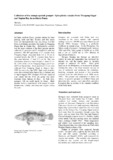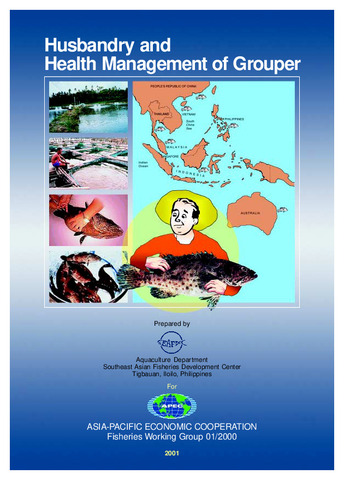Perlihatkan publikasi sederhana
Intracellular production of recombinant GnRH1 in yeast, Pichia pastoris, and its potential as oral treatment to advance gonadal development in juvenile orange-spotted grouper, Epinephelus coioides
| dc.contributor.author | Nocillado, Josephine | |
| dc.contributor.author | Palma, Peter | |
| dc.contributor.author | Wang, Tianfang | |
| dc.contributor.author | de Jesus-Ayson, Evelyn Grace T. | |
| dc.contributor.author | Levavi-Sivan, Berta | |
| dc.contributor.author | Elizur, Abigail | |
| dc.date.accessioned | 2022-03-21T03:54:56Z | |
| dc.date.available | 2022-03-21T03:54:56Z | |
| dc.date.issued | 2022-05 | |
| dc.identifier.citation | Nocillado, J., Palma, P., Wang, T., de Jesus-Ayson, E. G., Levavi-Sivan, B., & Elizur, A. (2022). Intracellular production of recombinant GnRH1 in yeast, Pichia pastoris, and its potential as oral treatment to advance gonadal development in juvenile orange-spotted grouper, Epinephelus coioides. Aquaculture, 554, 738115. | en |
| dc.identifier.issn | 0044-8486 | |
| dc.identifier.uri | http://hdl.handle.net/10862/6308 | |
| dc.description.abstract | Late maturation and large size at maturity are significant challenges when administering hormonal treatments in captive broodstock. Here, we report the potential of yeast, Pichia pastoris, as a vehicle to orally deliver a recombinant gonadotropin-releasing hormone (rGnRH1) aimed at stimulating gonadal development in juvenile orange-spotted grouper, Epinephelus coioides. Two recombinant GnRH1 constructs were designed utilizing pPIC3.5, the yeast expression vector lacking a signal sequence, hence retaining the recombinant within the yeast. The first construct (rGnRH1_1xGAP) comprised of GnRH1 decapeptide and the GnRH-associated peptide (GAP) separated by a cleavage site. The second construct (rGnRH1_10x) consisted of ten GnRH1 decapeptides, each separated by a cleavage site. Expression of the two recombinant peptides was confirmed by mass spectrometry. ELISA for the GnRH analogue (GnRHa) was validated to determine the level of rGnRH1 from the yeast extracts. Parallelism between the serially diluted GnRHa and serially diluted extracts from recombinant yeast confirmed validity of the assay. A luciferase reporter assay showed stimulation of tilapia GnRH type 3 receptor by the yeast extract, suggesting biological activity in vitro. In a short term experiment, lyophilised yeast loaded in gelatine capsules and fed once to juvenile orange-spotted grouper resulted in a significantly higher plasma GnRH compared with the control. In a 4-week experiment, lyophilized yeast containing either rGnRH1_1xGAP or rGnRH1_10x was incorporated in fish pellets and fed daily at a dose of 1 μg rGnRH1/kg fish body weight/day. The mean gonadosomatic index and oocyte diameter did not vary between the treated and control fish. The mean plasma levels of FSH, LH and GnRH in the rGnRH1-fed and control fish did not also vary significantly, however there were individuals in the rGnRH1-fed groups that had increased level of the hormones. Together with histological evidence showing oocyte development in a proportion of fish fed with the recombinant, results of the present study point to a biological activity in vivo of the rGnRH1 in yeast. With further refinement, this technology has the potential to provide a non-invasive method for broodstock management of large, late-maturing species of fish and of small, delicate endangered species that require breeding in captivity. | en |
| dc.description.sponsorship | This project was funded by grants to AE from the Australian Seafood CRC (No. 2008-745: The advancement of reproductive development in Southern bluefin tuna using hormonal manipulations of kisspeptin, the gatekeeper of puberty) and from the Australian Centre for International Agricultural Research (ACIAR FIS_2012_101: Developing technologies for giant grouper, Epinephelus lanceolatus, aquaculture in Vietnam, the Philippines and Australia). This study was also partly funded by SEAFDEC/AQD (Study Codes: TV-01-F2020T, Br-03-F2018T). PP was supported by a John Allwright Fellowship from ACIAR. | en |
| dc.language.iso | en | en |
| dc.publisher | Elsevier | en |
| dc.subject | oral delivery | en |
| dc.subject | Pichia pastoris | en |
| dc.subject | groupers | en |
| dc.subject | recombinant GnRH | en |
| dc.subject | GnRH | en |
| dc.subject | Epinephelus coioides | en |
| dc.title | Intracellular production of recombinant GnRH1 in yeast, Pichia pastoris, and its potential as oral treatment to advance gonadal development in juvenile orange-spotted grouper, Epinephelus coioides | en |
| dc.type | Article | en |
| dc.identifier.doi | 10.1016/j.aquaculture.2022.738115 | |
| dc.citation.volume | 554 | |
| dc.citation.spage | 738115 | |
| dc.citation.journalTitle | Aquaculture | en |
| dc.subject.asfa | yeasts | en |
| dc.subject.asfa | hormones | en |
| dc.subject.scientificName | Epinephelus coioides | en |
| dc.subject.scientificName | Pichia pastoris | en |
Files in this item
| Files | Size | Format | View |
|---|---|---|---|
|
There are no files associated with this item. |
|||
Publikasi ini ada di koleksi berikut
-
Journal Articles [1256]
These papers were contributed by Department staff to various national and international journals.



